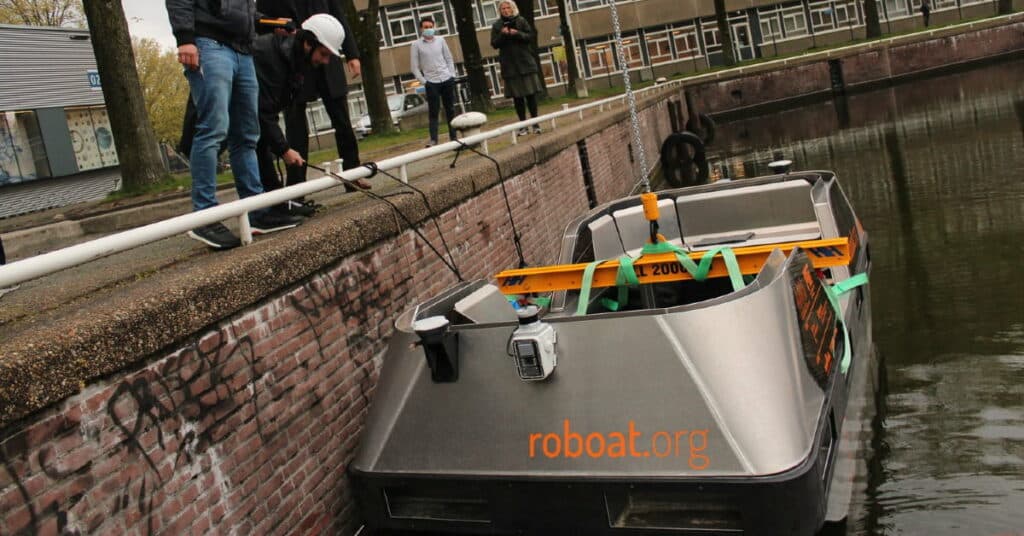Amsterdam, the capital city of The Netherlands, has positioned itself as a major player when it comes to implementing visionary projects in favour of sustainable economic development.
In fact, Amsterdam launched the Smart City initiative in 2009 to shape the city of the future by bringing citizens, knowledge institutions, businesses, and public authorities together. In 2016, Amsterdam won Europe’s Capital of Innovation award.
Fast-forward to 2022, there are startups and institutions working on the smart, green, and healthy future of the Amsterdam Metropolitan Area.
Here’s a list of startups and institutions that are making Amsterdam a smart city. Take a look.

The Great Bubble Barrier
The Great Bubble Barrier is on a mission to remove tonnes of plastics from rivers globally. In 2019, the first Bubble Barrier was deployed in Westerdok to make the city of Amsterdam a global pioneer in the fight against plastic pollution.
The Bubble Barrier is a curtain of air bubbles created by pumping compressed air through a perforated tube that is placed at the bottom of the canal. The rising bubbles form an upwards current, which brings plastic to the surface of the water. The Bubble Barrier works 24×7 and does not interfere with shipping or wildlife.

Johan Cruijff ArenA
Johan Cruijff ArenA in Amsterdam is much more than an iconic football stadium. The stadium’s ecosystem serves as a platform for innovation.
Startups with good ideas are encouraged to pitch their product on the Football Innovation Platform, where they will be connected to a score of experts. The best ideas can score a deal where their idea is implemented in the stadium.
Located in Amsterdam South-East, the stadium and its partners are testing solutions for business and societal challenges in crowd control, mobility, security, sustainability, fan experience, citizen wellbeing, and open platform collaboration.
At present, Johan Cruijff ArenA is working on two crucial challenges – to reduce the carbon footprint of fans travelling to and from stadiums, and to reduce litter and make waste more circular in the stadium or amateur clubs.

Marineterrein Amsterdam
The Marineterrein is the creative and technological hub in Amsterdam. It is the place where businesses, institutions, colleges, and universities can conduct experiments in the field of learning, working and living.
Through a flexible approach, Marineterrein is gradually developing the test area into an urban district where there will be room for open innovation and new forms of housing, sports, recreation, and greenery.
At present, Marineterrein Amsterdam is focusing on the Living Lab project which uses the terrain as an experimental environment for its development. Together with Amsterdam Smart City and NEMO Science Museum, Living Lab creates and develops experiments that are tested on the grounds, and ultimately applied in urban environments.

Amsterdam Smart City
Amsterdam Smart City is an open innovation platform of the Amsterdam Metropolitan Area. The initiative aims to achieve sustainable economic growth, efficient use of natural resources, and high quality of life.
At present, the areas of interest for developing projects, ideas and new business models are smart housing, open data, smart grids, home energy storage, connectivity, and smart mobility.
Since the initiative’s inception, Amsterdam Smart City has grown to be a platform with over 100 partners active in more than 70 innovative projects. Together, they work on solutions to improve the quality of life in urban regions.

Amsterdam Institute for Advanced Metropolitan Solutions
AMS Institute is a collaboration between the Massachusetts Institute of Technology, Wageningen University & Research, Delft University of Technology, and the City of Amsterdam.
It is a leading knowledge institute that designs solutions for urban challenges. Scientists, students, engineers, and designers work together to develop interdisciplinary solutions. They do this together with the City of Amsterdam and a network of partners from research institutes, industry, social institutions, and residents.
Currently, AMS Institute is involved in five projects within the living lab: Roboat, Space For Food, Respyre, Responsible Sensing Lab, and Husky.

Startup in Residence
Startup in Residence is an incubation programme that connects entrepreneurs with key social and urban challenges in Amsterdam to stimulate innovation.
The government’s startup programme is a six-month venture wherein participating startups receive training, mentorship and resources to test out their ideas directly in the city of Amsterdam. If the solutions prove successful, the municipality will invest in the startup or become its launching customer.
Startup in Residence is an initiative of Startup Amsterdam and the Chief Technology Office (CTO) of the City of Amsterdam, modelled on a similar programme in San Francisco.

Cyberbank
Amsterdam is becoming increasingly digital post-COVID-19 pandemic, however, there is a bit of a digital divide between those who have access to the internet and technology, and those who don’t. Here’s where Cyberbank comes into play.
People in Amsterdam who can’t afford a laptop of their own can pick up a refurbished device. Barring the €20 deposit, the laptops are free of charge.
Cyberbank is an initiative of organisations Cybersoek, ICT Vanaf Morgen en Allemaal Digitaal.
The bank says that around 20 per cent of people in Amsterdam lack digital skills. For low-income people, buying a laptop or computer can be too expensive. Similar to a food bank handing out food, the Cyberbank hands out laptops to those in need.
Besides supporting the people of Amsterdam with hardware, Cyberbank also supplies digital support for people that need help using their devices.

Tapp
Tapp is a smart city design agency helping local governments and citizens create more inclusive, responsive, and sustainable future cities.
The platform builds teams from designers to programmers to social scientists for specific assignments, ensuring each project has the right balance of complementary skills needed to achieve the most effective results.
The agency uses agile and lean startup methodologies to quickly solve many urgent social, environmental and economic challenges.
To date, Tapp’s projects have ranged from using cameras to improve crowds and recreation spaces to testing public reaction to autonomous vehicles.
One such is the Public Eye initiative. It is an open-source crowd monitoring solution that helps municipal innovators acquire actionable insights about busy inner-city hot spots.
It uses Crowd Monitoring System Amsterdam (CMSA), a monitoring system with counting cameras and wifi sensors that give insight into the numbers and densities of pedestrians.
In the pilot Public Eye Amsterdam, the crowdedness in a number of places in Amsterdam is being mapped with an open-source part of the data system of CMSA.
There are cameras in these locations and they are linked to a server of the municipality. The information about the number of people detected is forwarded to municipal employees and facility managers, who can then use the count to better regulate traffic.










01
From telecom veteran to Dutch Startup Visa success: The Jignesh Dave story